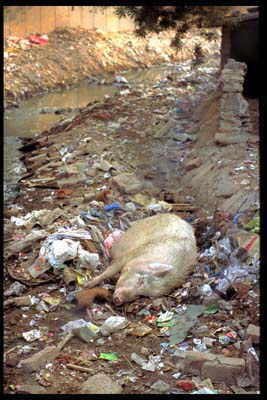because of slow turnover. The major water pollutants are organic nutrients, inorganic nutrients, infectious agents, toxic organics, toxic inorganics, sediment and heat. Organic nutrients come from feedlots, municipal sewage treatment plants, and industry. They promote growth of natural populations of aquatic bacteria. Bacterial decomposition of organic materials results in declines in dissolved oxygen, with dire effects on other oxygen-requiring organisms. Two inorganic plant nutrients of major concern are nitrogen and phosphorus. They come primarily from septic tanks, barnyards, heavily fertilized crops, and sewage treatment plants, and cause excessive plant growth that clogs navigable waterways. Bacterial decay of plants in the fall result in a drop in dissolved oxygen, which may suffocate fish and other organisms.
Water may contain pathogenic bacteria, viruses, protozoans, parasites (infectious agents). Untreated or improperly treated sewage, animal wastes, meat-packing wastes, and some wild species are the major sources. Waterborne infectious diseases present a special problem in developing nations with poorly developed sewage treatment facilities. Toxic organic pollutants include a large number of chemicals, such as pesticides and PCBs, many of which are nonbiodegradable or slowly degraded, biologically magnified and carcinogenic.
Toxic inorganic pollutants include a wide range of chemicals, such as metals and salts, from a wide array of sources. Mercury is a particularly troublesome pollutant because it is converted into methyl and dimethyl mercury in a aquatic ecosystem by aerobic bacteria. These forms are more toxic than inorganic mercury. Methyl mercury is biologically magnified in the food chain.
Sediment, the leading water pollutant in the United States, is a by-product of erosion resulting from poorly managed timber cutting, agriculture, ranching, mining and construction.
|
| Sediment destroys spawning and feeding grounds for fish, reduces fish and shellfish populations, destroys pools used for resting, smothers eggs and fry, fills in lakes and streams, and decreases light penetration, thus endangering aquatic plants. |  |
Thermal pollution refers to the heating or cooling of water, both of which drastically alter biota in a body of water. Large quantities of heat can kill heat-sensitive organisms and harm organisms dependent on the aquatic ecosystem. The concentration of many pollutants in groundwater is often higher than that in the most contaminated surface water supplies. Many of the chemicals are tasteless and odorless at concentrations believed to pose a threat to human health. The major groundwater pollutants are chlorides, nitrates, heavy metals, and toxic organics.
|
| The oceans receive pollutants from many sources. Oil pollutions is one of the more serious problems. About half of the oil that contaminates the ocean comes from human sources: oil well blowouts, tanker spills, and inland disposal of oil. Oil harms many organisms, especially if a spill occurs near an estuarine zone. | |
It may take two to ten years for aquatic life to recover from a spill. Thanks to public outcry and stricter controls, the number of oil spills has decreased substantially, although the problem is far from solved.
Plastic pollution has also become a major problem throughout the world. Plastic nets, plastic garbage, and plastic medical wastes are killing millions of marine mammals, turtles, and fish. Animals may become tangles in the plastic debris or may eat it and die. Because of public outcry, many governments have banned the dumping of plastics in oceans.

How to Prevent Water Pollution Water can get polluted due to many reasons. These reasons are mainly related to human activities. We need to control water pollution. Knowing how to prevent water pollution is very important and will help us save our planets.
Without water nothing can survive and we see that we have polluted water to a great extent. This can be seen in the rivers, beaches and lakes around us.
Water pollution starts at our home. We contaminate the water we drink by following many such activities that can pollute water. This polluted water enters into our body through various sources such as plants and sea food and indirectly creates complications. Some of the diseases like typhoid, vomiting, nausea, headache and many such water-borne diseases are a cause of water pollution.
Polluted water enters the food chain and affects all the organisms in the chain. Some of the pollutants in water are so dangerous that they can even cause death.

Water pollution may also affect the aquatic life. It may cause turbidity in aquatic plants and animals. It may also cause depletion of oxygen i.e. anoxia in plants and sea animals.
How to prevent water pollution:
There are many things that we can do to prevent water pollution. It is up to us to take proper preventive measures so that we get safe water for us and all the living organisms.
|
|